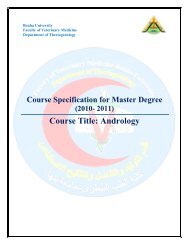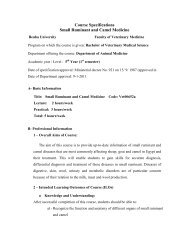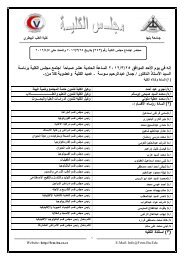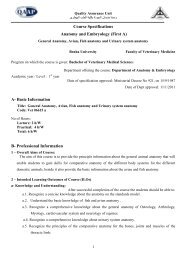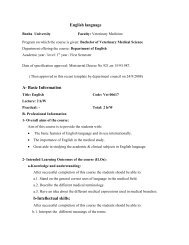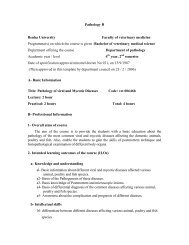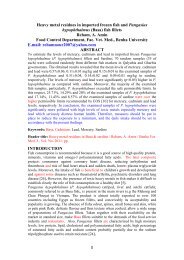BENHA VETERINARY MEDICAL JOURNAL BENHA VETERINARY ...
BENHA VETERINARY MEDICAL JOURNAL BENHA VETERINARY ...
BENHA VETERINARY MEDICAL JOURNAL BENHA VETERINARY ...
Create successful ePaper yourself
Turn your PDF publications into a flip-book with our unique Google optimized e-Paper software.
<strong>BENHA</strong> <strong>VETERINARY</strong> <strong>MEDICAL</strong> <strong>JOURNAL</strong><br />
INSTRUCTIONS TO AUTHORS<br />
key words or phrases that are useful for<br />
indexing. Subtitles may be put to<br />
amplify the title; however, they should<br />
be able to stand-alone.<br />
4.2.2. Authorship<br />
Authors should be indicated<br />
immediately below the title or subtitle.<br />
It includes each author‟s full name and<br />
address with postal code of the<br />
institution where the study was done.<br />
Persons who made subsidiary<br />
contribution may be listed in the<br />
“Acknowledgments”.<br />
4.2.3. Running head<br />
Running head not exceeding 40<br />
characters including spaces should be<br />
provided on the first page.<br />
4.2.4. Corresponding author<br />
An e-mail address with name of an<br />
author, to whom all the correspondence<br />
regarding the manuscript is to be<br />
directed, must be provided at the<br />
bottom of the title page. The e-mail<br />
address will appear in the first page of<br />
the published article for readers who<br />
may want to request reprints or<br />
additional information.<br />
4.3. Abstract<br />
Abstract summarizes the main points<br />
of an article: (1) the purpose of the<br />
study, (2) the basic procedures, (3) the<br />
main findings, and (4) the principal<br />
conclusions. The abstract should be<br />
clearly understood in itself. Avoid<br />
abbreviations or symbols, which are<br />
not easily understood by general<br />
scientific readers.<br />
4.4. Keywords<br />
Three to five key words, which<br />
represent key concepts of the paper,<br />
should be given at the end of the<br />
abstract in an alphabetical order. The<br />
words included in the Title or Abstract<br />
would not be indexed as key words.<br />
4.5. Materials and Methods<br />
This section should provide readers<br />
with sufficient information to replicate<br />
the work. Although it is not necessary<br />
to give details of published<br />
methodology if appropriately cited,<br />
any modifications must be described.<br />
Information regarding statistical<br />
analysis of the data should be included.<br />
4.6. Results and Discussion<br />
The Results section should briefly<br />
present the experimental data in the<br />
text, tables, or figures. For details on<br />
the preparation of tables and figures,<br />
see below. The Discussion should<br />
focus on the interpretation and<br />
significance of the findings with<br />
concise objective comments that<br />
describe their relation to other work in<br />
that area. The Discussion should not<br />
reiterate the Results. Results and<br />
Discussion sections might be<br />
combined, if necessary.<br />
4.7. Acknowledgment (s)<br />
Authors should acknowledge here for<br />
financial support, gift of materials,<br />
technical help, editorial assistance, etc.<br />
4.8. References<br />
References should be cited in the text<br />
by Arabic numeral in square brackets,<br />
e.g. [1, 2–5, 7]. They should be listed<br />
in the order of appearance in the text.<br />
Articles included in the reference list<br />
must appear in publications that are<br />
accessible to most scientists. Reference<br />
material that has been accepted for<br />
publication must be listed as “in<br />
press”: the listing must include journal<br />
title and anticipated year of<br />
iii



